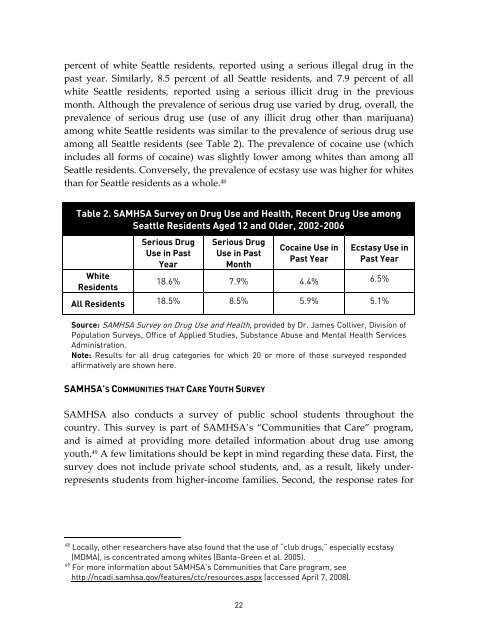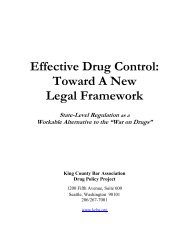RACE AND THE ENFORCEMENT OF DRUG DELIVERY LAWS IN ...
RACE AND THE ENFORCEMENT OF DRUG DELIVERY LAWS IN ...
RACE AND THE ENFORCEMENT OF DRUG DELIVERY LAWS IN ...
Create successful ePaper yourself
Turn your PDF publications into a flip-book with our unique Google optimized e-Paper software.
percent of white Seattle residents, reported using a serious illegal drug in the<br />
past year. Similarly, 8.5 percent of all Seattle residents, and 7.9 percent of all<br />
white Seattle residents, reported using a serious illicit drug in the previous<br />
month. Although the prevalence of serious drug use varied by drug, overall, the<br />
prevalence of serious drug use (use of any illicit drug other than marijuana)<br />
among white Seattle residents was similar to the prevalence of serious drug use<br />
among all Seattle residents (see Table 2). The prevalence of cocaine use (which<br />
includes all forms of cocaine) was slightly lower among whites than among all<br />
Seattle residents. Conversely, the prevalence of ecstasy use was higher for whites<br />
than for Seattle residents as a whole. 48<br />
Table 2. SAMHSA Survey on Drug Use and Health, Recent Drug Use among<br />
Seattle Residents Aged 12 and Older, 2002-2006<br />
White<br />
Residents<br />
Serious Drug<br />
Use in Past<br />
Year<br />
Serious Drug<br />
Use in Past<br />
Month<br />
Cocaine Use in<br />
Past Year<br />
Ecstasy Use in<br />
Past Year<br />
18.6% 7.9% 4.4% 6.5%<br />
All Residents 18.5% 8.5% 5.9% 5.1%<br />
Source: SAMHSA Survey on Drug Use and Health, provided by Dr. James Colliver, Division of<br />
Population Surveys, Office of Applied Studies, Substance Abuse and Mental Health Services<br />
Administration.<br />
Note: Results for all drug categories for which 20 or more of those surveyed responded<br />
affirmatively are shown here.<br />
SAMHSA’S COMMUNITIES THAT CARE YOUTH SURVEY<br />
SAMHSA also conducts a survey of public school students throughout the<br />
country. This survey is part of SAMHSA’s “Communities that Care” program,<br />
and is aimed at providing more detailed information about drug use among<br />
youth. 49 A few limitations should be kept in mind regarding these data. First, the<br />
survey does not include private school students, and, as a result, likely underrepresents<br />
students from higher-income families. Second, the response rates for<br />
48 Locally, other researchers have also found that the use of “club drugs,” especially ecstasy<br />
(MDMA), is concentrated among whites (Banta-Green et al. 2005).<br />
49 For more information about SAMHSA’s Communities that Care program, see<br />
http://ncadi.samhsa.gov/features/ctc/resources.aspx (accessed April 7, 2008).<br />
22

















